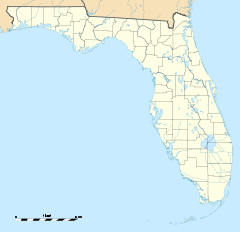- Dinner Key
-
United States Coast Guard Air Station at Dinner Key
 One of the former Coast Guard hangars
One of the former Coast Guard hangarsCoordinates: 25°43′41″N 80°14′05″W / 25.72806°N 80.23472°WCoordinates: 25°43′41″N 80°14′05″W / 25.72806°N 80.23472°W Built: 1917 Architect: United States Coast Guard; Fred Howland Architectural style: Mission Revival/Moderne NRHP Reference#: 02001535 Added to NRHP: February 20, 1975 Dinner Key is a marina complex in the Coconut Grove neighborhood of Miami, Florida along the shore of Biscayne Bay on South Bayshore Drive. It was originally an island, but was connected to the mainland in 1914 by filling in the intervening space. An early source attributes the name to the fact that the island was a convenient place to stop to eat while traveling by boat between the mouth of the Miami River and Snapper Creek south of Miami.[1] Dinner Key is accessible by public transit via the Coconut Grove Circulator from the Miami Metrorail at Coconut Grove and Douglas Road stations.
Contents
History
A United States Naval Air Station was established on Dinner Key in 1917. NAS Dinner Key, commanded by Lt. Cdr. Marc Mitscher, was the second largest naval air facility in the U.S. and was used to train seaplane pilots.[2][3] The Air Station was closed shortly after the end of World War I and taken over by commercial operators. The Navy returned to Dinner Key during World War II, operating there from 1943 until 1945.
Dinner Key served as a base for Pan American World Airways's flying boats during the 1930s and 1940s. It was one of the world's largest airports and the main hub for air traffic between North and South America. After the technological advances of World War II and the construction of suitable airports in South America made seaplanes largely obsolete, Pan Am transferred its operations to Miami International Airport.
The United States Coast Guard operated an Air Station at Dinner Key from 1932 until 1965, when operations were transferred to the Opa-locka Airport. The former barracks and mess building were added to the U.S. National Register of Historic Places on August 10, 1995.[4]
One of Pan Am's hangars was used for many years as an exhibition hall and auditorium, the Dinner Key Auditorium. It was recently renamed the Coconut Grove Convention Center. This was the site of the incident in 1969 in which Jim Morrison of the Doors was arrested for exposing himself to the audience.[5] The Miami Floridians professional basketball team played some of its games at the auditorium in the late 1960s and early 1970s.[6] On December 19, 2002, it was added to the U.S. National Register of Historic Places.[4]
Today, Dinner Key is used primarily as a marina. Three of Pan Am's original four hangars remain in use for boat storage. The old Pan Am terminal building has served as the Miami City Hall since 1954.[7] It was added to the U.S. National Register of Historic Places on February 20, 1975.[4]
Gallery
References
- ^ Munroe, Ralph M. and Vincent Gilpin. (1930) The Commodore's Story. New York: Ives Washburn. p. 119
- ^ Taylor, Theodore (2006). Magnificent Mitscher. Annapolis, MD: Naval Institute Press. p. 48.
- ^ Munroe, Ralph M. and Vincent Gilpin. (1930) The Commodore's Story. New York: Ives Washburn. p. 330
- ^ a b c National Register of Historic Places - Dade County listings - URL retrieved October 24, 2006
- ^ Mary Werbelow, Jim Morrison and the Doors - URL retrieved June 18, 2006
- ^ Tays, Alan (December 11, 2005). "For Today, ABA's Floridians More than a Memory". Palm Beach Post. http://findarticles.com/p/news-articles/palm-beach-post/mi_8163/is_20051211/abas-floridians-memory/ai_n51901259/. Retrieved 18 April 2011.
- ^ Miami City Hall history - URL retrieved June 18, 2006
Source
- Florida, DK Eyewitness Travel Guides, 2004, pg. 83
Categories:- Aviation history
- History of Miami, Florida
- National Register of Historic Places in Miami-Dade County, Florida
- Keys in Miami-Dade County, Florida
- Islands of Miami, Florida
- Pan Am
- Coconut Grove (Miami)
Wikimedia Foundation. 2010.



